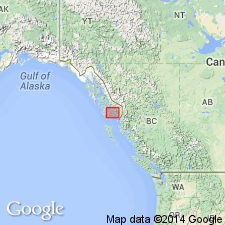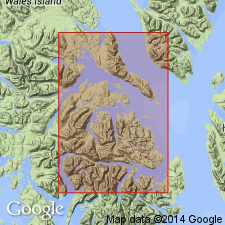
- Usage in publication:
-
- Kasaan greenstone*
- Modifications:
-
- Named
- Dominant lithology:
-
- Greenstone
- AAPG geologic province:
-
- Alaska Southeastern region
Summary:
Occurs on Prince of Wales Island at Kasaan Bay peninsula and Skowl Arm region and on Cleveland Peninsula as shown on geologic reconnaissance map of part of Ketchikan mining district, southeastern AK. Includes variety of types but as a rule it is pale- or dark-green massive rock. Belt on western part of Cleveland Peninsula is dioritic phase. "It is often impossible in the field to distinguish the Kasaan greenstone from the older greenstones associated with the Wales series [new]." p.49. Formation contains copper ores and possibly nickel ores as well. Greenstone was extruded after deformation of Wales and Ketchikan series (new). Is probably Early Cretaceous age (time of volcanic activity in Queen Charlotte Islands.)
Source: GNU records (USGS DDS-6; Menlo GNULEX).

- Usage in publication:
-
- Kasaan greenstone†
- Modifications:
-
- Abandoned
- AAPG geologic province:
-
- Alaska Southeastern region
Summary:
Term Kasaan greenstone of Brooks (1902) was applied to rocks on Kasaan Peninsula but detailed study has shown they are graywackes containing in certain places tuffaceous material. [Name Kasaan greenstone is abandoned and replaced on map with informal lithologic types.]
Source: GNU records (USGS DDS-6; Menlo GNULEX).
For more information, please contact Nancy Stamm, Geologic Names Committee Secretary.
Asterisk (*) indicates published by U.S. Geological Survey authors.
"No current usage" (†) implies that a name has been abandoned or has fallen into disuse. Former usage and, if known, replacement name given in parentheses ( ).
Slash (/) indicates name conflicts with nomenclatural guidelines (CSN, 1933; ACSN, 1961, 1970; NACSN, 1983, 2005, 2021). May be explained within brackets ([ ]).

